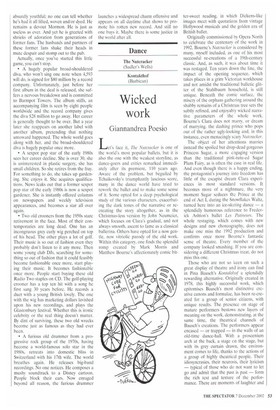Dance
The Nutcracker (Sadler's Wells) Kontakthof (Barbican)
Wicked work
Giannandrea Poesio
Let's face it, The Nutcracker is one of the world's most popular ballets, but it is also the one with the weakest storyline, as dance-goers and critics remarked immediately after its premiere, 110 years ago. Aware of the problem, but beguiled by Tchaikovsky's triumphantly luscious score, many in the dance world have tried to rework the ballet and to make some sense of it. Some opted for a deep psychological study of the various characters, exacerbating the dark tones of the narrative or recreating the story altogether, as in the Christmas-less version by John Neumeier, which focuses on Clara's gradual, and not always smooth, ascent to fame as a classical ballerina. Others have opted for a now gentle, now vitriolic parody of the old work. Within this category, one finds the splendid romp created by Mark Morris and Matthew Bourne's affectionately comic bit
ter-sweet reading, in which Dickens-like images meet with quotations from vintage Hollywood musicals and the golden era of British ballet.
Originally commissioned by Opera North to celebrate the centenary of the work in 1992, Bourne's Nutcracker is considered by many, myself included, as one of his most successful re-creations of a 19th-century classic. And, as such, it was about time it was restaged. Ten years down the line, the impact of the opening sequence, which takes places in a grim Victorian workhouse and not amidst the traditional balletic glitter of the Stablbaum household, is still unique. Beneath the comic surface, the misery of the orphans gathering around the shabby remains of a Christmas tree sets the subtly refined, and enjoyably wicked narrative parameters of the whole work. Bourne's Clara does not marry, or dream of marrying, the dashing prince who pops out of the rather ugly-looking and, in this instance, even menacingly scary Nutcracker.
The object of her attentions marries instead the spoiled but drop-dead gorgeous Princess Sugar, a more engaging version than the traditional pink-tutu-ed Sugar Plum Fairy, as is often the case in real life. And even though there is a happy ending, the protagonist's journey into freedom has little of the escapist dream Clara experiences in most standard versions. It becomes more of a nightmare, the very moment Sugar seduces the Prince at the end of Act I, during the Snowflakes Waltz, turned here into an ice-skating dance a splendidly humorous reference to Frederick Ashton's ballet Les Patineurs. The whole restaging, which comes with new designs and new choreography, does not make one miss the 1992 production and confirms once more Bourne's fantastic sense of theatre. Every member of the company looked smashing. If you are considering a different Christmas treat, do not miss this one.
Those who are not so keen on such a great display of theatre and irony can find in Firm Bausch's Kontakthof a splendidly rewarding alternative. Originally created in 1978, this highly successful work, which epitomises Bausch's most distinctive creative canons and formulae, has been re-created for a group of senior citizens, with unique results. The presence on stage of mature performers bestows new layers of meaning on the work, demonstrating, at the same time, the theatrical channels of Bausch's creations. The performers appear encased — or trapped — in the walls of an old-time dance-hall. With a proscenium arch at the back, a stage on the stage, but with its grey curtain drawn, the environment comes to life, thanks to the actions of a group of highly theatrical people. Their idiosyncrasies, their neurosis, their lyricism — typical of those who do not want to let go and admit that the past is past — form the rich text and texture of the performance. There are moments of laughter and moments that make one reflect on, rather bitterly, both ephemeral and serious issues. There are also the typical Bausch 'walks', and the connoisseur recognises immediately familiar Bauschian solutions, such as the use of high heels, more or less explicit references to sexual desires and fantasies, an intentionally accentuated gender distinction, and so on.
Above all, this new Kontakthof can be read as Bausch's equivalent of Proust's search for a long-lost youth. The length of the performance does not get in the way of appreciating the whole, even though some repetitions have lost their impact. This was one of the greatest events of the current season and makes one long for much more.











































































 Previous page
Previous page